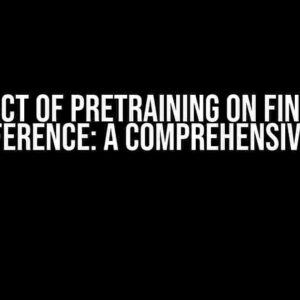Are you frustrated with the OpenAI API either not answering your question or leaving you clueless about where to find the response? You’re not alone! Many developers and enthusiasts have struggled with this issue, but fear not, dear reader, for we’re about to dive into the world of OpenAI API and uncover the solutions to this perplexing problem.
Understanding How OpenAI API Works
To tackle the issue of missing responses, it’s essential to understand how the OpenAI API functions. The API is a powerful tool that uses artificial intelligence to process natural language inputs and generate human-like responses. Here’s a high-level overview of the API’s architecture:
- Request: You send a request to the OpenAI API with a question or task.
- Processing: The API processes your request using its AI model, which generates a response.
- Response: The API returns the response to your request.
Sounds simple, right? But what happens when the response doesn’t come or is nowhere to be found?
Common Causes of Missing Responses
Before we dive into the solutions, let’s explore some common reasons why you might not be getting the response you expect:
- Invalid API Key or Authentication: Make sure your API key is valid, and you’re authenticating correctly.
- Incomplete or Malformed Request: Double-check that your request is properly formatted and includes all required parameters.
- Rate Limiting: If you’re making too many requests too quickly, you might hit the rate limit. Check the API documentation for rate limit details.
- API Errors or Downtime: Sometimes, the API might be experiencing errors or downtime. Check the OpenAI API status page or social media for updates.
- Complexity or Ambiguity of the Question: If your question is too complex or ambiguous, the API might struggle to provide a clear response.
Troubleshooting Techniques
Now that we’ve covered the common causes, let’s move on to some troubleshooting techniques to help you find that elusive response:
Check the API Response Object
When you make a request to the OpenAI API, the response comes in the form of a JSON object. Make sure to inspect the response object carefully to ensure you’re not missing the response.
{
"status": "success",
"response": {
"text": "The response you're looking for!"
}
}
In this example, the response is nested within the `response` object. Make sure to access the correct property to retrieve the response.
Use the `stream` Parameter
The `stream` parameter allows you to receive the response in real-time, which can be helpful in identifying issues. Set `stream` to `true` in your request:
curl -X POST \
https://api.openai.com/v1/completions \
-H 'Authorization: Bearer YOUR_API_KEY' \
-H 'Content-Type: application/json' \
-d '{"prompt": "Your question", "stream": true}'
This will return a stream of responses, which can help you identify if the API is struggling to provide a response.
Check the API Logs
If you’re still having trouble, check the API logs to see if there are any errors or issues. You can find the logs in the OpenAI API dashboard or through the API itself.
curl -X GET \
https://api.openai.com/v1/logs \
-H 'Authorization: Bearer YOUR_API_KEY'
Inspect the logs to identify any errors or warnings that might be related to your request.
Best Practices for Crafting Effective Requests
To avoid missing responses, follow these best practices when crafting your requests:
| Best Practice | Description |
|---|---|
| Clear and Concise Language | Use simple, direct language when asking your question. Avoid ambiguity and complexity. |
| Specific and Well-Defined Prompts | Make sure your prompt is specific and well-defined, including any necessary context or requirements. |
| Avoid Overly Broad or Open-Ended Questions | Try to avoid asking overly broad or open-ended questions that might confuse the API. |
| Use Relevant and Accurate Keywords | Use relevant and accurate keywords in your prompt to help the API understand the context. |
| Test and Refine Your Request | Test your request and refine it as needed to ensure you’re getting the response you expect. |
Conclusion
By understanding how the OpenAI API works, identifying common causes of missing responses, troubleshooting with the right techniques, and following best practices for crafting effective requests, you’ll be well on your way to unlocking the secrets of the OpenAI API and finding the responses you need.
Remember, the OpenAI API is a powerful tool, but it’s not magic. With patience, persistence, and practice, you can master the art of getting the responses you want.
Happy coding, and may the responses be ever in your favor!
Frequently Asked Question
Are you frustrated with the OpenAI API not answering your questions or hiding the responses from you? Don’t worry, we’ve got you covered! Check out these FAQs to get clarity on what’s going on.
Why does the OpenAI API not answer my question?
The OpenAI API might not answer your question if it’s too complex, ambiguous, or outside its knowledge domain. Make sure to rephrase your question, break it down into simpler parts, or provide more context to help the API understand what you’re asking.
Where can I find the response to my question in the OpenAI API?
Check the API response carefully, as the answer might be hidden in a nested JSON object or encoded in a specific format. Use a JSON viewer or a debugging tool to inspect the response and extract the relevant information.
Is it possible that the OpenAI API is not trained to answer my specific question?
Yes, it’s possible that the OpenAI API hasn’t seen your specific question before or isn’t trained to answer it. The API’s knowledge domain and training data have limitations, so it’s essential to understand its capabilities and limitations.
How can I improve the chances of getting a response from the OpenAI API?
To increase the chances of getting a response, make sure to provide clear and concise questions, use natural language, and avoid ambiguity. Also, check the API documentation and follow the recommended guidelines for formatting and syntax.
What should I do if I’m unsure about the accuracy of the OpenAI API’s response?
If you’re unsure about the accuracy of the response, verify it against trusted sources, such as official documentation, academic papers, or expert opinions. You can also try rephrasing the question or asking follow-up questions to clarify any doubts.


